Related Research Articles

The Louisiana Purchase was the acquisition of the territory of Louisiana by the United States from the French First Republic in 1803. This consisted of most of the land in the Mississippi River's drainage basin west of the river. In return for fifteen million dollars, or approximately eighteen dollars per square mile, the United States nominally acquired a total of 828,000 sq mi now in the Central United States. However, France only controlled a small fraction of this area, most of which was inhabited by Native Americans; effectively, for the majority of the area, the United States bought the preemptive right to obtain Indian lands by treaty or by conquest, to the exclusion of other colonial powers.
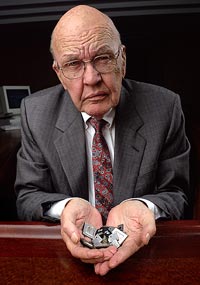
Jack St. Clair Kilby was an American electrical engineer who took part, along with Robert Noyce of Fairchild Semiconductor, in the realization of the first integrated circuit while working at Texas Instruments (TI) in 1958. He was awarded the Nobel Prize in Physics on 10 December 2000.
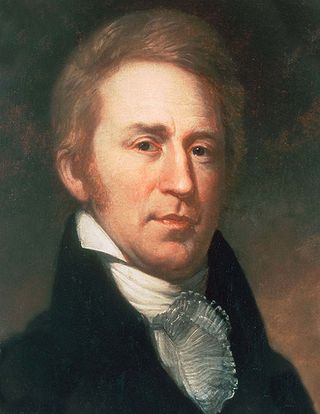
William Clark was an American explorer, soldier, Indian agent, and territorial governor. A native of Virginia, he grew up in pre-statehood Kentucky before later settling in what became the state of Missouri.
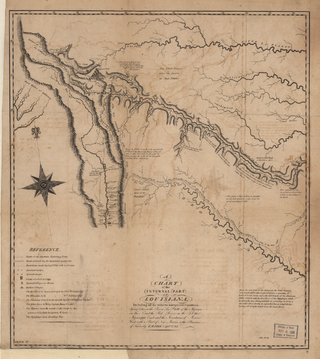
The Pike Expedition was a military party sent out by President Thomas Jefferson and authorized by the United States government to explore the south and west of the recent Louisiana Purchase. Roughly contemporaneous with the Lewis and Clark Expedition, it was led by United States Army Lieutenant Zebulon Pike, Jr. who was promoted to captain during the trip. It was the first official American effort to explore the western Great Plains and the Rocky Mountains in present-day Colorado. Pike contacted several Native American tribes during his travels and informed them that the U.S. now claimed their territory. The expedition documented the United States' discovery of Tava which was later renamed Pikes Peak in honor of Pike. After splitting up his men, Pike led the larger contingent to find the headwaters of the Red River. A smaller group returned safely to the U.S. Army fort in St. Louis, Missouri before winter set in.

Southern Methodist University (SMU) is a private research university in University Park, Texas, United States, with a satellite campus in Taos County, New Mexico. SMU was founded on April 17, 1911, by the Methodist Episcopal Church, South—now part of the United Methodist Church—in partnership with Dallas civic leaders. However, it is nonsectarian in its teaching and enrolls students of all religious affiliations. It is classified among "R-2: Doctoral Universities – High Research Activity".
Earle Gene Labor was an American writer. A George Wilson Professor (Emeritus) of American Literature at Centenary College of Louisiana, his research and teaching career was devoted to the study of the American author, Jack London. He taught the first undergraduate course devoted to London at Utah State University in 1966. Labor taught the first-ever graduate course on London in 1973-74 while on a Fulbright Scholarship.
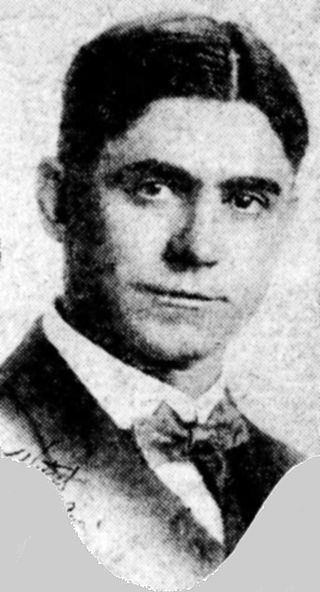
Charles Claude Selecman was an American Methodist pastor and the third president of Southern Methodist University from 1923 to 1938. Selecman entered office during a difficult financial time for SMU and managed to put the university on sounder footing while expanding the campus and growing the enrollment. These achievements would largely be overshadowed, however, by his chilling effect on SMU's intellectual and social environment.
The trans-Mississippi theater of the American Civil War was the scene of the major military operations west of the Mississippi River. The area is often thought of as excluding the states and territories bordering the Pacific Ocean, which formed the Pacific coast theater of the American Civil War (1861–1865).
SMU Dedman School of Law, commonly referred to as SMU Law School or Dedman School of Law, is a law school located in Dallas, Texas. Jason P. Nance serves as its current dean.
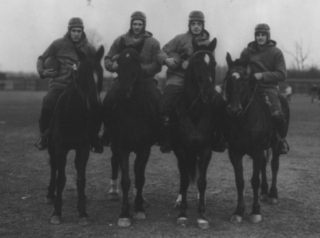
The 1924 college football season was the year of the Four Horsemen as the Notre Dame team, coached by Knute Rockne, won all of its games, including the Rose Bowl, to be acclaimed as the best team in the nation. Notre Dame and Stanford were both unbeaten at season's end, with the Fighting Irish winning the Rose Bowl contest 27–10. The Penn Quakers were retroactively awarded a national championship by Parke H. Davis.
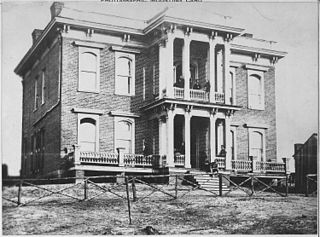
The U.S. Army Corps of Topographical Engineers was a branch of the United States Army authorized on 4 July 1838. It consisted only of officers who were handpicked from West Point and was used for mapping and the design and construction of federal civil works such as lighthouses and other coastal fortifications and navigational routes. Members included such officers as George Meade, John C. Frémont, Thomas J. Cram and Stephen Long. It was merged with the United States Army Corps of Engineers on 31 March 1863, at which point the Corps of Engineers also assumed the Lakes Survey for the Great Lakes. In the mid-19th century, Corps of Engineers' officers ran Lighthouse Districts in tandem with U.S. Naval officers.

Everette Lee DeGolyer, was a prominent oil company executive, petroleum exploration geophysicist and philanthropist in Dallas. He was known as "the founder of applied geophysics in the petroleum industry", and as "the father of American geophysics," and was a legendary collector of rare and often early edition books primarily in the fields of Southwestern history, railroads, law, geology, science, and both English and American literature.
Umphrey Lee was a Methodist theologian and historian who served as the fourth president of Southern Methodist University from 1939 to 1954. Lee, who had been SMU's first undergraduate student body president, succeeded religious hard-liner C. C. Selecman, and is remembered for fostering an intellectual environment conducive to free research and learning. Along with Dean Merrimon Cuninggim, he was also the driving force behind the effort to begin desegregating SMU in 1952—years before other southern colleges and fellow Methodist universities, Duke University and Emory University.
Kidd-Key College was a college and music conservatory for women located in Sherman, Texas. The college was established in 1877 as the North Texas Female College, although its origins were in a private high school, the Sherman Male and Female High School. At the time, a college for women was a new idea. In 1901, the college acquired the campus of the Mary Nash College. It changed its name to Kidd-Key in 1919, in memory of its first President, but closed in 1935, largely due to the old-fashioned rules for student life that were enforced.
Julia Scott Reed was a journalist, editor and radio broadcaster. She became the first African American columnist at the Dallas Morning News in 1967.
Ermance Rejebian was an Armenian American woman who captivated Texas audiences with her ardor as a book reviewer, lecturer, broadcaster, and writer. During her 40+ year career, she inspired dozens of book clubs and wrote two books detailing her and her husband's struggles amidst the Armenian genocide.

Robert Yarnall Richie (1908–1984) was an American photographer who worked as a freelance commercial and industrial photographer, in Texas and worldwide. Richie's work is significant for its artistic qualities as well as documentary information. Richie may be best known for his oil production and aviation images in such areas as Texas, Louisiana, the Gulf of Mexico, and Saudi Arabia.
Charles Betts Waite was an American photographer who worked in Mexico at the turn of the twentieth century. He signed his work C. B. Waite, and his full name is often mistakenly stated as Charles Burlingame Waite.
Hugo Brehme, was a German-born photographer of Mexico. Working almost exclusively in black and white, he established a photographic studio in Mexico City “Fotografía Artística Hugo Brehme“ as early as 1912. It was a successful business for forty years. His subject matter photos of traditional rural Mexico, scenic landscapes, railways, modern monuments and archeological sites. His picturesque photos were placed in tourist guides and magazines and he produced a large number of photos for postcards. He was an early mentor of noted Mexican photographer Manuel Alvarez Bravo.
William Talbot Handy, Jr. was an American civil rights activist and Methodist bishop. He served as the residing bishop of the Missouri Annual Conference of the United Methodist Church from 1980 to 1992. A friend of Rev. Martin Luther King, Jr., Handy was active in the Civil Rights movement and helped lead the Louisiana State Advisory Committee of the United States Commission on Civil Rights and the Baton Rouge chapter of the National Association for the Advancement of Colored People. He was the first African-American to serve in an executive capacity at the United Methodist Publishing House.
References
- ↑ "Gift of rare manuscript celebrates opening of George W. Bush Presidential Center". Southern Methodist University. Retrieved 27 April 2013.
- ↑ Native American History Primary Sources. Silliman Family Papers, Yale University Library. Retrieved 16 April 2013.
- ↑ Yale Finding Aid Database. Guide to the Silliman Family Papers, Yale University Library. Retrieved 16 April 2013.
- 1 2 3 Brown, Michael. Dealer's description of An Account of Four Years Travels through the Illinois, Indiana, Louisiana, Missouri and Mississippi Territories with a True and Accurate Account of Every Principal River West of the Mississippi from the Missouri down to Red River Explaining their Different Lengths and Courses, the White Inhabitants and Towns with an Account of the Natives Inhabiting on These Rivers from their Sources to their Confluence, also an Account of the Mines and Minerals, Salines, and Natural Curiosities, Soil Productions and Staple Commodities Shewing the Advantages and Disadvantages of Trade both among the Whites and Natives of the Country Intermixed with an Account of the Author’s Wonderful Sufferings and Fatigues During the Expedition. By John Maley.
- ↑ Flores, Dan L. "Texas Iron," Handbook of Texas Online. Retrieved April 22, 2013.
- ↑ Goetzmann, William H. Exploration and Empire: The Explorer and the Scientist in the Winning of the American West, pp. 54-55